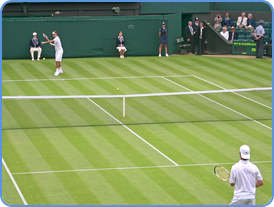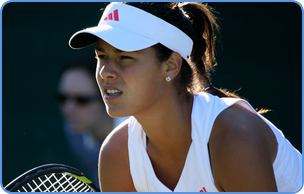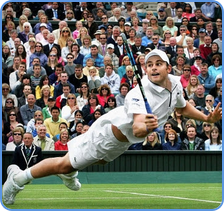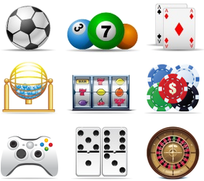 |
Advanced Tennis Betting Strategies |
Tennis game offers many opportunities for betting, with plenty of areas in which bettors can take advantage of odds and turn them in their favour. One of the simplest ways of doing this is by using tennis advanced betting strategies, and applying these methods to serious live betting.
If you are novice tennis bettor, we encourage you to visit our another educative page:
Beginners guide to tennis betting. Enjoy!
If you are novice tennis bettor, we encourage you to visit our another educative page:
Beginners guide to tennis betting. Enjoy!
Value Betting in Tennis
 |
Value betting is essentially finding odds on a player higher than what the predicted chance for them to win the match should be. Bookmakers compile their odds by calculating the percentage probability in which a player has to win the match, and simply turn this percentage into odds.
The easiest way of doing this is to calculate 100 / Percentage = The Odds of that player, and to get the odds from a percentage you would simply calculate 100 / The Odds = percentage probability.
Value is finding instances where the odds don’t tally with the overall probability of that player winning the match. |
For instance, when you flip a coin you have a 50% chance it will land either side, and the odds for this probable outcome would be 100 / 50 (the percentage) = 2.00, which are respective of evens in betting terms.
However, if you were offered odds of 2.50 or 3.00 for a coin flip, you would begin to make money.
Why is this?
When flipping a coin we know it has a 50/50 chance of landing either side, and the odds respective of this are 50%. However, if you calculate 100/2.50, the percentage now equals to 40%, and this means that the odds are representing a much lower chance of winning, and do not tally with the actual percentage of 50%.
This would be called a value bet, because for every £10 you risk, you stand to win £15 profit, and if you were to win 50% of your coin flips, you would be making £25 profit each 5 wins in 10.
Why is this?
When flipping a coin we know it has a 50/50 chance of landing either side, and the odds respective of this are 50%. However, if you calculate 100/2.50, the percentage now equals to 40%, and this means that the odds are representing a much lower chance of winning, and do not tally with the actual percentage of 50%.
This would be called a value bet, because for every £10 you risk, you stand to win £15 profit, and if you were to win 50% of your coin flips, you would be making £25 profit each 5 wins in 10.
This concept can be used in sports, and it’s always best to make a quick calculation before you place a bet on a tennis match of what percentage YOU think a player has of winning a match, and not always go off what the bookmaker is telling you.
Please take a look at some examples below for further clarification.
Please take a look at some examples below for further clarification.
An example in a tennis match:
 |
Let us assume that Maria Sharapova plays against Ana Ivanovic (on the left picture). Sharapova is priced at odds of 1.30, with Ivanovic priced at odds of 3.00.
These odds are created by the bookmaker from percentages, and these percentages are the probabilities in which the bookmaker thinks each player has to win the match. In this instance the bookmaker believes Sharapova has a 76% of winning the match (calculated using 100 / 1.30 (100 divided by the ODDS), and Ivanovic has a 33% chance of winning the match (calculated using 100 / 3.00). |
Now let's say, after your own analysis you believe that Ivanovic actually has a 50% chance of winning the match not 33%. If you truly do believe she has a 50% chance at winning the match, you have now discovered a value bet.
The reason for this is that you believe Ivanovic stands a higher chance at winning the match than the bookmaker does at 33%, and if you get odds of 3.00 each time a player has a 50% chance of winning a match, you will make money long-term, so long as they win 50% of the matches.
The reason for this is that you believe Ivanovic stands a higher chance at winning the match than the bookmaker does at 33%, and if you get odds of 3.00 each time a player has a 50% chance of winning a match, you will make money long-term, so long as they win 50% of the matches.
If you win 5 out of 10 matches at odds of 3.00 your profit would £50 from a £10 stake on each bet.
If you win 3 out of 10 matches at odds of 3.00 however (the odds which the bookmaker are offering), you would lose £10.
If you win 3 out of 10 matches at odds of 3.00 however (the odds which the bookmaker are offering), you would lose £10.
This is how important value betting is, and how you can use this to enhance your long-term betting and make money. The tricky part of this aspect of betting however, is finding the true probability of a player winning the match.
Someone may think a player has a 40% chance of winning a match, another person may think they have a 70% chance of winning a match, and it’s all about practice and finding a sound strategy in which you can use to calculate odds yourself consistently.
Most people do overlook this area of betting, and people do not realise that this is why bookmakers make so a lot of money from gamblers who bet without proper knowledge of the match they are betting on.
Someone may think a player has a 40% chance of winning a match, another person may think they have a 70% chance of winning a match, and it’s all about practice and finding a sound strategy in which you can use to calculate odds yourself consistently.
Most people do overlook this area of betting, and people do not realise that this is why bookmakers make so a lot of money from gamblers who bet without proper knowledge of the match they are betting on.
Backing Against Favourites in the First Rounds of Minor Tournaments
One strategy which can be used prior to a tournament starting is to back against strong favourites during the first round. This strategy is especially effective after a major grand slam event.
Big favourite players who have played well consistently up until a tournament are usually worth fading or not backing at all in their next tournament. Players who have just won a title at a prior tournament are usually happy, have made many points in the rankings, and their next tournament isn’t of too much importance to them.
An example of this situation would be with Serena Williams at the earlier stages of 2014. Williams won the title in Miami on hard courts, and then went to start the clay court season in Charleston. Williams was knocked out of the first round by Cepelova priced at 18/1 in straight sets.
Please avoid backing players in doubles tournaments if they’re still in the singles draw
This is a method that is quite overlooked by some people who bet on doubles in tennis. This strategy should always be taken into consideration when choosing to back a particular team in a doubles match.
Every tournament usually features a doubles draw, with grand slam events including mixed doubles as well.
Every tournament usually features a doubles draw, with grand slam events including mixed doubles as well.
 |
Generally speaking, if a player still remains in the singles draw of the tournament and is playing in the doubles draw too, it’s best to avoid betting on them in their doubles matches.
The reason for this, is that tennis players mind will generally be more focused on their singles draw success rather than their doubles draw, mainly due to higher prize money offered in the singles draw, and more chance to improve their position in the rankings. Some players are also not too familiar with doubles, and may not like playing it. These players will usually ensure they get knocked out during the early stages of the doubles tournament so they can focus on their singles campaign. |
In-Play Betting Strategies
In-play betting offers many different opportunities to back players at better odds than before the start of the match, and can also lead to some good trading opportunities if you bet on betting exchange too.
Back a player when they’re 15-40 down to win the game
Some bookmakers and betting exchanges will allow you to bet on the current game in progress. However, this strategy can be used on betting exchange using the set betting markets by trading out at a better price if the game betting market isn't available.
Statistically, 55% of the time a player who is 15-40 down when serving will usually go on to win the game. If your bookmaker is offering you higher odds than 2.30 for the current player who is 15-40 down on serve to win the current game, take this bet.
Typically this strategy should be used in men's tennis, mainly due to men tennis players are having a more dominative serve, and are able to claw themselves out of danger more easily than women. However, this could be incorporated in women's tennis as well if the odds are high enough.
Statistically, 55% of the time a player who is 15-40 down when serving will usually go on to win the game. If your bookmaker is offering you higher odds than 2.30 for the current player who is 15-40 down on serve to win the current game, take this bet.
Typically this strategy should be used in men's tennis, mainly due to men tennis players are having a more dominative serve, and are able to claw themselves out of danger more easily than women. However, this could be incorporated in women's tennis as well if the odds are high enough.
Back under 9.5 games in the next set following a tie-break
Around 70% of the time the set following a tie-break is usually a short one, and is usually under 9.5 games, such as 6-3, 6-2, 6-1, or 6-0.
Here are the two most common reasons why this happens:
- The underdog wins the first set with a tie-break after failing to break his/her opponent.
In the second set, the underdog can no longer cope with the pressure of the match, starts to become tired, and the initial favourite in the match comes back to win 2-1. - The favourite or underdog wins the first set with a tie-break, and goes on to win the match 2-0.
This happens when the first set has been quite competitive, but soon after in the second set, the player who lost the first set gives up and can no longer keep up with their opponent.
We believe that there are some other advanced techniques of tennis betting that you successfully use. If you want to add any great strategy to this page, please send me a message using contact us page. Thank you.
All of these strategies can be used to enhance and improve your betting experience. However, please remember to judge each and every match on its own merit, and gamble responsibly.
All of these strategies can be used to enhance and improve your betting experience. However, please remember to judge each and every match on its own merit, and gamble responsibly.






